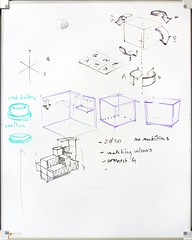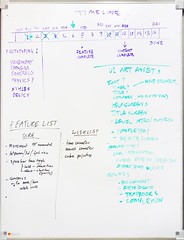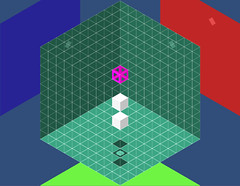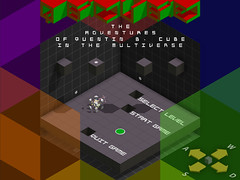QBCUBE Post-Mortem
fouad | articles, games22 Jul 2010

As with so many stories, this one begins with ideas scribbled on a napkin. It was at Bon’s, the local greasy spoon, that the ideas for what was to become QBCUBE were first thrown around between the three of us. The world would be a much less interesting place were it not for cheap, all-day breakfast specials.
The Cost of Pre-production so far:
Gas to get to Bon’s: $1
Breakfast special for three: $10.50
Game ideas scribbled on napkins: Priceless…
Like many other indie studios out there, we’d been lamenting everything that is wrong with the game industry for some time. Tired of the stereotypical designs and overproduced, soulless junk that’s flooded the industry, we set out to create something simple, fun and challenging. As a company that holds principles of rapid prototyping close to heart, and having a little time to spare between projects, we thought it would be an interesting exercise to see what type of game we could hammer out, start to finish, in just a little over two weeks. 12 working days later, we’re here now to break down what worked well and the challenges we faced along the way.



The Goal:
To explore principles of interactivity by building a fun, fully functional game in 12 days. Stick it to ‘the man’ by creating something great in a short amount of time, without bloated visuals or features.The Idea:
A physics-based game utilizing gravity in an original way.The Team:
Two artists, one coder. Always pushing ourselves to do more, with better results, in less time.
Rapid Prototyping
Developing the game based on constant internal play testing allowed us to solve problems as soon as they arose. Inviting external testers in as soon as we had something to play allowed us to keep an objective perspective on the experience we were creating, making sure it was actually fun and not just our egos telling us so.Unity
The little engine that could is getting bigger every day, and is changing the indie gaming and visualization marketplace as we speak. The project couldn’t have happened without it.Unique Retro Look + Feel
Fouad and Josh had the look and feel of the game pinned down in the first two days of development. Initially, colours were used to help the player orient himself in a constantly rotating world, and aid with navigation. This later turned into its own unique visual aesthetic.Sonic Tribute to the Commodore 64
Classic sound effects support the retro aesthetic while also paying tribute to all the brilliant games that have long since been forgotten. Being an avid Commodore enthusiast, Fouad culled all the sound effects and music for QBCUBE from old C64 favorites. UPDATE: We replaced the C64 music with some royalty-free music composed by Kevin Macleod.Capitalizing on Strengths
Paradoxically, working within limitations can be very liberating. By being familiar with the technology we’re using, we were able to capitalize on strengths and avoid weaknesses. A few examples include:
– The orthographic design. Sometimes, simple is just better. Flattening perspective/removing depth-cues helped us devise and implement new kinds of challenges.
– Efficient / smart use of shaders and built-in unity effects.
– Keeping modeling and animation requirements to a minimum. Creating elaborate art assets requires copious amounts of time, numerous revisions and a boatload of finesse – luxuries we could not afford.
Trimming the Fat
Locking down the key mechanics and features early in the development process allowed more time for Q/A and polish, which was absolutely crucial. We reserved a full quarter of our development time for polish and fine-tuning. As well, it allowed us to more fully explore the key mechanics in a thorough and satisfying manner without being distracted by fluff.Building a Sandbox
Again, keeping things focused and lean allowed for more experimentation and honing. Being able to play with the ‘building blocks’ of the game from very early on meant we could quickly begin brainstorming level and puzzle ideas.
Scope
The importance of maintaining focus can’t be overemphasized. On a production timeline as contracted as the one we were operating on, focus was paramount. There wasn’t time to waste fleshing out ideas that would not ultimately make it into the game. We know, we know – it would be awesome to have switches, teleporters, trap doors, rockets and even flying monkeys throwing explosive shit-kebabs. Maybe next time…Physics vs. Control
Although the original concept of the game was based on using real (simulated) physics (supported natively in the engine), we quickly realized real physics was too unpredictable for the experience we were trying to create. We ended up canning real physics in favor of designing a more controlled, predictable experience for the user.Level Design
Interesting camera schemes make for even more interesting level design challenges. Much thought had to be given to clearly thought-out and structured levels to allow for adequate visibility. The key challenge in the level design was keeping a close eye on the difficulty curve while making sure we thoroughly explored the mechanics as the levels progressed. Carefully introducing new elements to the mix ensured players who persevered would stay engaged and experience the satisfaction of solving some of the harder puzzles.Easy to Pick Up, Hard to Put Down?
Being so familiar with the puzzles and mechanics of the game, we ran the risk of quickly losing touch with how unfamiliar the controls/concept could seem to new players. Frequent player testing was invaluable in enabling us to attenuate the difficulty levels.Making Complex Controls Accessible
We knew that the game would be unplayable if the fundamental ‘toggle time/gravity’ system was too cumbersome or overly complicated. Using the space-bar in conjunction with the WASD keys worked as a comfortable solution, although some players were not attuned to using the WASD control system popular with players of FPS-type games. So, later on we decided to enable arrow keys as well. Allowing the player to manipulate the world in six different rotational directions can make things quite disorienting – making the implementation of this adequately intuitive was probably the greatest challenge we faced on the project.
What would we do differently?
Probably, not enough time was devoted to gently introducing players into the world of QBCUBE. Creating a tutorial level or help screens would have helped in this aspect. Otherwise, the project has exceeded our expectations and we can comfortably say we surpassed the goal we set for ourselves.Words of Wisdom
Just do it. Build the first iteration quickly, and play with it. Small, confident steps. Reiterate. Repeat. Real-world simulation is exciting, but is it necessary to build a fun game? The popular emphasis on photo-realism, at least from a game design perspective, is fundamentally misplaced.What Next
Porting to iOS (iPhone OS). This is something we’re considering based on the positive feedback we’ve received so far. The much ballyhooed accelerometer functionality of the iPhone has been brought up repeatedly as a potential means to control the rotation of the world. At the risk of speaking too soon, our feeling is that this could easily become too gimmicky and inaccurate a control system for a game that often requires carefully considered decision making. Honing the touch-controls would need a significant amount of development time as well. Nevertheless, the notion of publishing QBCUBE to the iPhone is an exciting prospect and we’re weighing our options.How Do You Market Your Game?
This last question in particular poses a host of challenges all its own. For one thing, original sounds and music would have to be created, which could be more difficult than is immediately apparent. But that’s just the beginning. So far, we’ve carried out a cursory bit of research into game portals and other indie game forums, and although the iPhone App Store may be one answer, it’s become painfully clear that opportunities for financially profiting from QBCUBE are a bit thin on the ground. Still, the exercise was an educational one for us, and by writing this post-mortem, we hope that we can inspire other aspiring developers to venture into new and exciting game territory.
Due to the overwhelming response, we are seriously considering developing the QBCUBE prototype into a finished product. If you enjoyed the game and feel it has potential, you can help us by donating to the CatStatic QBCUBE fund. Any amount will be most sincerely appreciated!
QBCUBE has been polished up and given the full red-carpet treatment on Kongregate. Just in time for the Unity Game Contest!





Great information! I’ve been looking for something like this for a while now. Thanks!
Love QBCUBE!
Great game, very well done! Keep up the good work, guys!
[…] CatStatic Interactive | Interactive 3D Visualizations | Vancouver … […]